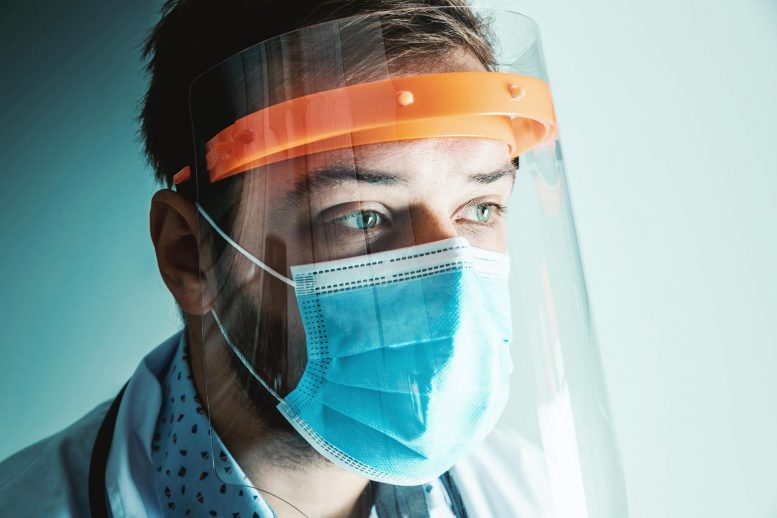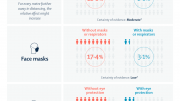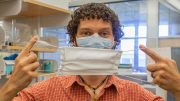
Face shields are popular because they do not obstruct breathing, allow for more natural conversation than face masks, and offer splash protection. Unfortunately, they do not provide high-level COVID protection.
The peer-reviewed study found that face shields did not give high levels of protection against external droplets.
According to a recent study from the University of East Anglia, if you used a face shield during the epidemic, it probably didn’t provide you with a high degree of protection against COVID-19. A study released today evaluated 13 different types of face shields in controlled laboratory environments.
While all of the face shields offered some protection, none provided high levels of protection from external droplets. In addition to doing laboratory studies on face shields, the research team polled individuals, including health workers, in middle-income nations (Brazil and Nigeria), regarding their attitudes about face shields as PPE.
Professor Paul Hunter, from UEA’s Norwich Medical School, said: “Face shields have been popular because they don’t hinder breathing, they allow more natural communication than face masks and they provide splash protection. They were widely used throughout the COVID pandemic. But until now there hasn’t been a great deal of evidence about how protective they really are – particularly taking into account how people use them in the real world, and especially in poorer parts of the world. We wanted to find out more about how protective different styles of face shields might be, both in the lab and in real-world settings.”
UEA researchers collaborated with staff at the Health and Safety Executive (HSE), Britain’s regulator for workplace health and safety, who tested 13 face shield designs in a controlled laboratory setting, using a ‘coughing machine’ that ejected fluorescent drops onto manikin heads.
How much the manikin face was contaminated by the simulated cough droplets was graded from most to least.
Dr. Julii Brainard, from UEA’s Norwich Medical School, said: “The lab tests showed that all of the face shields provided some protection, but none gave high levels of protection against external droplet contamination. The level of protection provided was influenced by design features, as well as which way the manikin had its head turned when it was ‘coughed’ at. We found that large gaps around the sides, and sometimes the bottom or top, allow respiratory droplets from other people to get to the face and this means exposure to possible viruses. The shields that offered most protection were closed across the forehead and extended well around the sides of the face and below the chin. It’s important to know that the lab experiments are in the scenario of someone actively coughing at the shield wearer from close proximity. But the chances of droplets getting around the shield onto the face from just speaking are much lower.”
To learn more about how face shields are used in a real-world setting, the team surveyed more than 600 people across Nigeria and Brazil, including health care staff.
Dr. Brainard said: “We wanted to know about how users cleaned them, and the things that mattered most when choosing facial PPE during the pandemic. Not surprisingly, we found that people want proven protective products that are comfortable, stable on their heads, easy to clean and don’t look strange. This study is important because the acceptability of facial PPE during the pandemic has been mostly studied in richer countries like the UK or USA. The participants in our study were in Nigeria and Brazil and we shouldn’t assume that people in all countries view facial PPE in the same way. It is also important to understand what design features in face shields could be more or less protective so that people are able to choose the most effective designs.
“Finally, we wanted to know how people cleaned reusable face shields – methylated or surgical spirits were popular, for instance, but so was plain water and soap. Some cleaning chemicals could be incompatible with shield coatings intended to prevent fogging or facilitate quick-drying, for instance. Dust outside and fogging inside shields were occasional problems, too,” she added.
The study was recently published in the American Journal of Infection Control. In a related project, the HSE team tested face shields available for use in the UK. The results of this work, together with more details of the cough simulator, are published in the journal Annals of Work Exposures and Health.
Dr. Brian Crook, a microbiologist on the HSE team, said: “It is important that people using any type of PPE to protect themselves from infection know how effective it is, but also its limitations. We are working with an international standards committee to write guidance towards a better means of providing that information.”
Reference: “Evaluation of Face Shields, Goggles, and Safety Glasses as a Virus Transmission Control Measure to Protect the Wearer Against Cough Droplets” by Samantha Hall, Paul Johnson, Claire Bailey, Zoe Gould, Robert White and Brian Crook, 20 July 2022, American Journal of Infection Control.
DOI: 10.1093/annweh/wxac047









Yup, the great reset continues, wear a mask, cover up, listen to the “science” and…
You’ll still get covid… But wearing a mask will make you look nice!
“if you used a face shield during the epidemic, it probably didn’t provide you with a high degree of protection against Covid”
Uh-oh, are they saying that next pandemic we only get to mask up? Or maybe just wear a bubble-boy suit?
What if we make the masks see-through mirrors? That way we still get to offer our individuality on the altar of progress and pretend-play pandemic-games along with the neurotic sycophant crazies while still being able to breath like a normal person. Also gets you that dystopian atmosphere everyone’s just dying to achieve in this life-time.
Win-win!
What a disgraceful headline! The word mask doesn’t even appear in the article. So how can you justify its use?
This isn’t journalism and it isn’t science, either. It’s propaganda.
Shame on you for underrating your readers powers of discernment and damaging your credibility so blatantly.
Oh, and just for the record, shouldn’t a science website be aware that the vast majority of studies into masks show they are of little or no value in stopping the spread of viruses?
Do email me a response – and show you at least have some editorial integrity by publishing this critical posting.